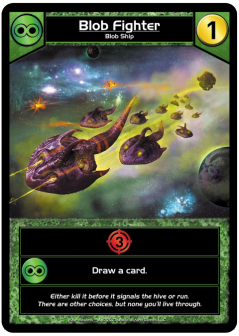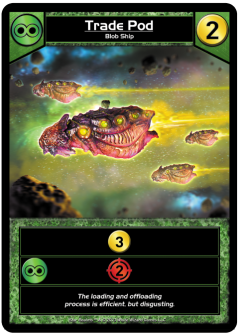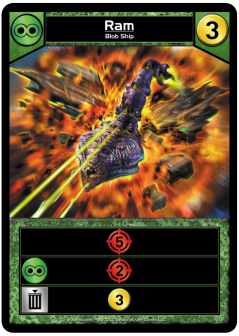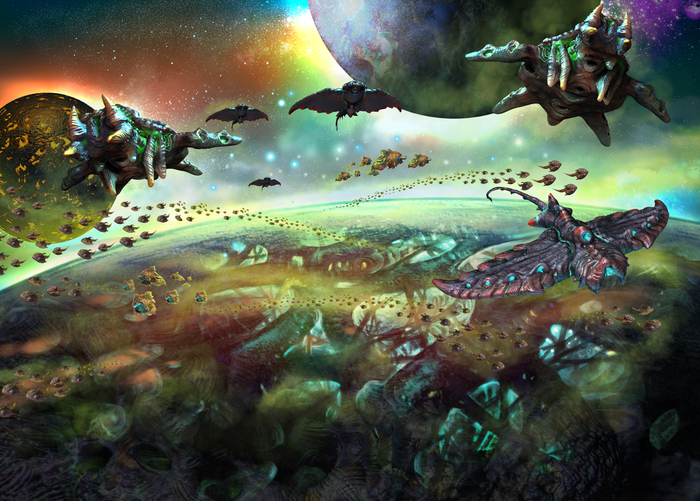Earlier this week I was able to sit down with Star Realms co-creator Rob Dougherty to discuss his new game and the recent recognition it has received. That interview gave me the opportunity to correct what I now realize was a grievous error on my part: I hadn’t played Star Realms yet. (Full disclosure: for this review I played only the digital version of the game, and have yet to try the physical game.)
To back up for a minute: The Star Realms deckbuilding game, released to the public in early 2014 after a successful Kickstarter campaign, has been picking up a lot of steam and recognition over the last year. Last week the game won South by Southwest (SXSW) Table Top Game of the Year, in the first year the category has existed. The game also won four 2014 Golden Geek Awards: Best Card Game, Best Two-Player Game, Best Indie Game (Digital), and Best Mobile/Handheld Game (notably defeating Blizzard’s Hearthstone: Heroes of Warcraft in the latter category). In other words, the game has been around for a little over a year now, and it’s starting to see some justified recognition. Let’s dive right in.
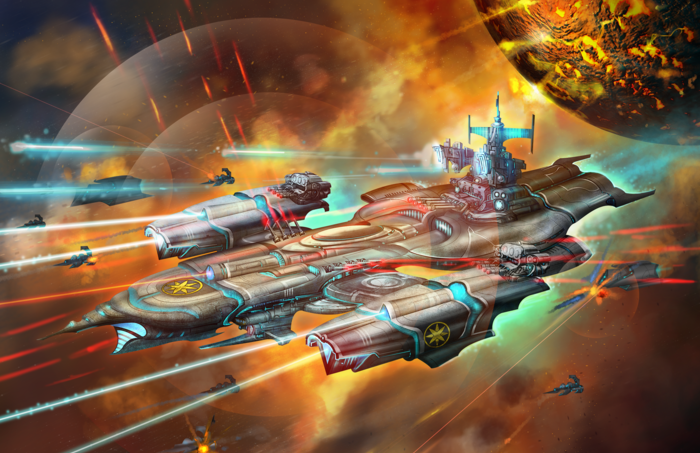 Star Realms was designed and developed by Rob Dougherty and Darwin Kastle, two former Magic: The Gathering pro players. Dougherty had a hand in designing the popular deckbuilder Ascension: Chronicle of the Godslayer. (Which Kastle contributed design and development work on as well)
Star Realms was designed and developed by Rob Dougherty and Darwin Kastle, two former Magic: The Gathering pro players. Dougherty had a hand in designing the popular deckbuilder Ascension: Chronicle of the Godslayer. (Which Kastle contributed design and development work on as well)
That connection to Ascension shows in the basic mechanics of Star Realms. Players start the game with a personal deck, seeded with eight Scouts (which provide trade points) and two Vipers (which provide combat points).
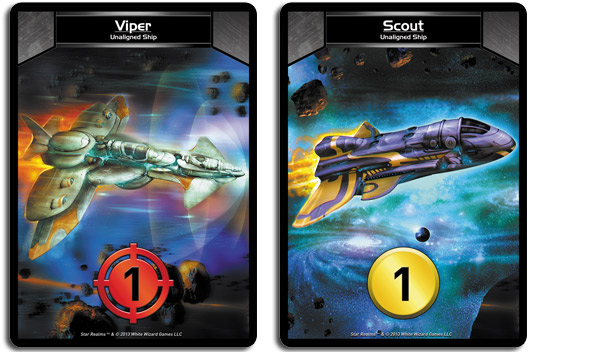 Players each purchase new cards from a communal trade row, which refreshes each time a new card is taken from it. Off to the side are a collection of Explorers, also available for purchase by either player.
Players each purchase new cards from a communal trade row, which refreshes each time a new card is taken from it. Off to the side are a collection of Explorers, also available for purchase by either player.
 The trade row cards are where the fun comes in. You start with five, and they’re dealt from a central Trade Deck—one new card to the trade row for each card which leaves it. Those cards are divided into four factions—the Trade Federation, the Blobs, the Star Empire, and the Machine Cult—each of which has their own specialties.
The trade row cards are where the fun comes in. You start with five, and they’re dealt from a central Trade Deck—one new card to the trade row for each card which leaves it. Those cards are divided into four factions—the Trade Federation, the Blobs, the Star Empire, and the Machine Cult—each of which has their own specialties.
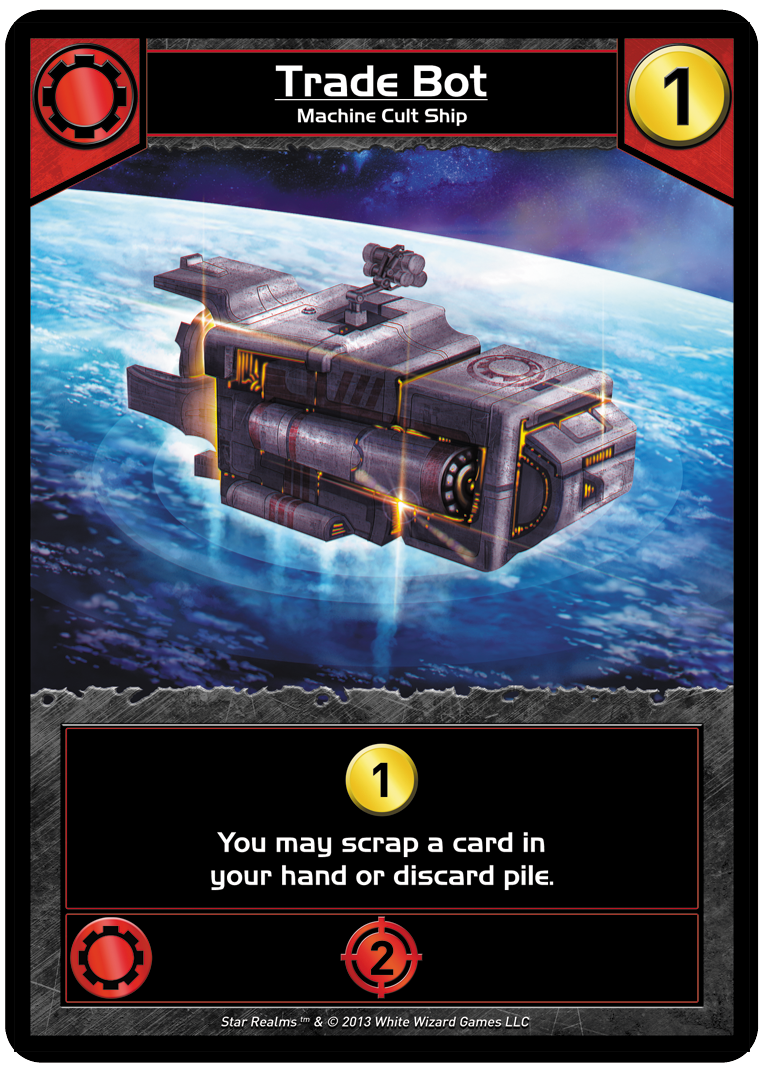
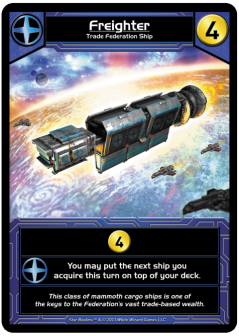 The Machine Cult, for example, has cards that let you permanently remove weaker cards from your deck, while the Trade Federation provides lots of buying power. Each faction has its own mechanical feel and a very distinct visual style, which makes recognizing the cards easy.
The Machine Cult, for example, has cards that let you permanently remove weaker cards from your deck, while the Trade Federation provides lots of buying power. Each faction has its own mechanical feel and a very distinct visual style, which makes recognizing the cards easy.
If this sounds similar to Ascension (which has Apprentices, Militia, and a common trade row), you’re not wrong. But as with every game, the devil is in the details, and in those details, Star Realms brings a number of innovations to the table.
First, the player-versus-player angle. Rather than compete to collect victory points (like Dominion) or to defeat monsters (like Ascension), players are trying to reduce each other’s Authority scores from 50 to 0. Players attack using combat points, which force opponents to lose Authority. Authority is essentially life points: when you run out, you lose. Some cards can give Authority back to the player; other cards function as roadblocks, which opponents must destroy before they can directly attack again.
The PVP element minimizes the “collective solitaire” feel which other deckbuilders sometimes have. While you have minimal ability to defend yourself, your opponent’s turn remains interesting, because they are trying to kill you. What they buy from the trade row is interesting, because it’s probably heading at your face in a few turns.
Star Realms isn’t the first deckbuilder to try such an approach—David Sirlin’s Puzzle Strike also played in this space—but the implementation here is cleaner and more intuitive. Very few cards in the game exist for the sole reason of providing combat points. More to the point, the heavy hitters of the game—the awesome flagships and motherships—are desirable cards when you see them on the trade row, and also excellent cards in your deck.

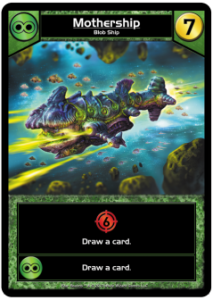
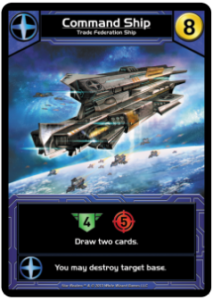 By putting the win condition directly on the cards you want to buy anyway, Star Realms eliminates the “feel-bad” moments that crop up in other deckbuilders, when you have to weigh buying a neat action card against buying something that will actually win you the game.
By putting the win condition directly on the cards you want to buy anyway, Star Realms eliminates the “feel-bad” moments that crop up in other deckbuilders, when you have to weigh buying a neat action card against buying something that will actually win you the game.
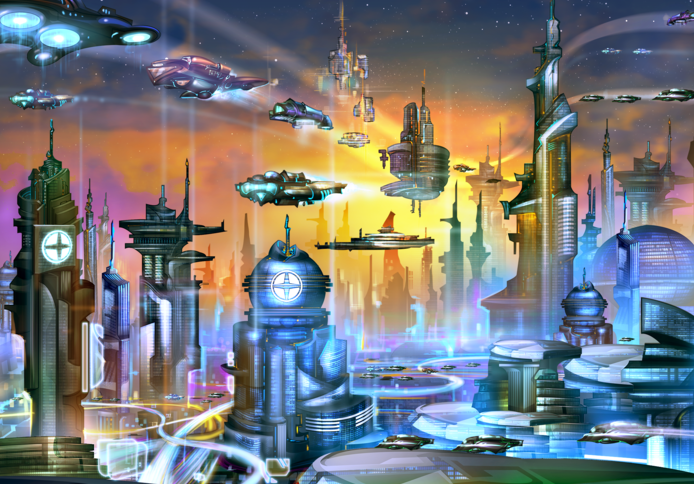 Star Realms also innovates through the Ally ability system. All cards have a basic power you get every time you play them. Most cards also have a bonus ally ability which you get if you play another card from the same faction during the same turn.
Star Realms also innovates through the Ally ability system. All cards have a basic power you get every time you play them. Most cards also have a bonus ally ability which you get if you play another card from the same faction during the same turn.
Ally abilities are great. They give players a clear goal—collect a lot of one particular faction. They’re a particular help to new players, who can get comfortable with the game’s mechanics without worrying too much about the cards they buy. They also save play time and deckbuilding space, as cards you acquire early continue to grow in power over the course of the game.
At the same time, ally abilities create interesting deckbuilding choices. They’re powerful, and you’ll want to trigger them, so once you’ve bought into a faction already, you’re encouraged to buy more. But, because the factions each have strengths and weaknesses, your deck will want powerful cards from multiple factions to cover its bases.
My one quibble about ally abilities is that it’s occasionally difficult to remember which ones you’ve activated and triggered when you have a big turn. (The digital game tracks all this for you, which makes me worry I’d forget it in the physical version.) Fortunately, the game usually ends after one or two big turns.
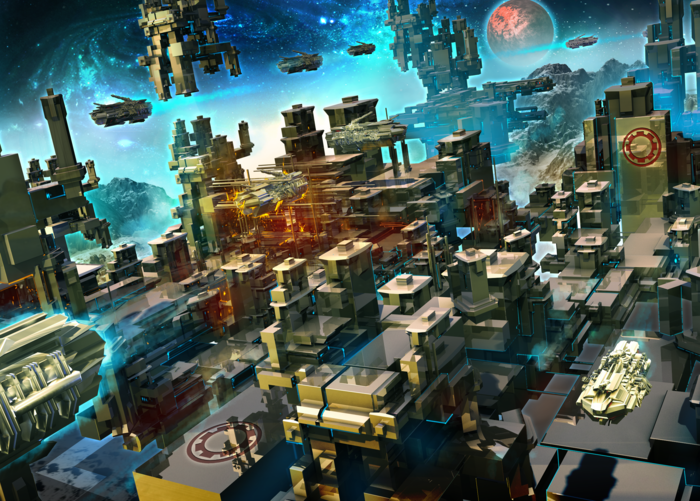 Star Realms also includes bases, a new spin on persistent cards. Like Ascension’s artifacts, they stay on the board when you play them from your hand and grant you useful abilities every turn—often a choice between two good options, so that you can stay flexible.
Star Realms also includes bases, a new spin on persistent cards. Like Ascension’s artifacts, they stay on the board when you play them from your hand and grant you useful abilities every turn—often a choice between two good options, so that you can stay flexible.
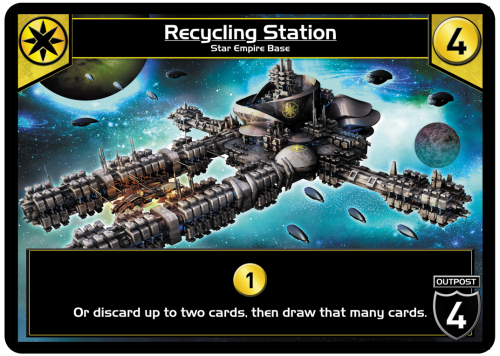 Your opponents can directly attack your bases to remove them from play (they can be shuffled back into your deck like other cards, so you’re not out the full investment). In fact, certain bases (“outposts”) have to be attacked first, so they can help form a defense line for you. Moreover, since each base is part of a faction, they give you a persistent way to turn on ally abilities.
Your opponents can directly attack your bases to remove them from play (they can be shuffled back into your deck like other cards, so you’re not out the full investment). In fact, certain bases (“outposts”) have to be attacked first, so they can help form a defense line for you. Moreover, since each base is part of a faction, they give you a persistent way to turn on ally abilities.
The “scrap” abilities which show up on various cards are another great innovation. These abilities give you an extra burst of action, at the cost of permanently removing the card from your deck.
Scrap abilities strike me as an example of what Magic: The Gathering Head Designer Mark Rosewater has referred to as “lenticular design”—designs which give experienced players more strategic options, but don’t overwhelm newer players, who don’t notice the depth of strategy.
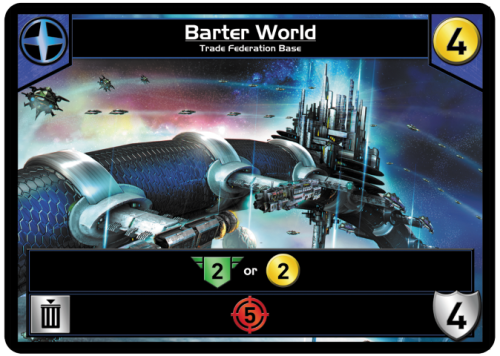 Even a first-time player can understand that it’s a good idea to scrap this base if the extra five combat will kill your opponent. But otherwise, they can ignore the scrap ability completely.
Even a first-time player can understand that it’s a good idea to scrap this base if the extra five combat will kill your opponent. But otherwise, they can ignore the scrap ability completely.
More experienced players will understand that the deck-thinning options scrap allows are powerful tools to have. Sometimes, you don’t want to draw your Explorer again, and when that time comes it painlessly removes itself from your deck.
Even better players can see that sometimes it’s right to buy a card out of the Trade Row, with the intent to scrap it when they draw it, just to keep it away from their opponent. That’s a ton of strategic depth packed into a seemingly simple mechanic, which doesn’t place an undue burden on card comprehension.
Digital Games
Star Realms is also available in digital form, available for download from the game’s website. The free version offers a tutorial mode, unlimited play against the easy-mode AI, and a short campaign mode. An additional purchase of $4.99 unlocks online PVP play, medium- and hard-difficulty AI, and another, longer campaign chapter. Versions link across platforms, so you can access content on your phone and computer alike.
The digital game is slick and well-produced, with crisp graphics, good sound, and surprising extras like voice-overs in campaign mission briefings and a background music track I actually found quite enjoyable. The game helpfully does all the bookkeeping on your abilities for you, which makes for some satisfying turns: when you play cards, sound effects trigger as you gain combat, trade, or authority, so your game erupts into a chorus of laser fire and clinking coins. It’s fun, and adds a nice visceral thrill to the gaming experience.
The digital version isn’t perfect; in particular, the game executes CPU actions quickly, and it was difficult to follow as I was just learning the game. An option to slow the pace, or a gamelog to explain actions as they happen, could have been a useful feature. The board occasionally becomes cluttered, though that’s usually toward the end of the game and lasts for a turn or two at most. Objects can sometimes be small, though it’s easy to right-click and zoom in.
Minor criticisms aside, the digital version of Star Realms is a great counterpart to the physical game and a great way to enjoy the game on the go. The team hopes to add organized play and in-app tournament support in the future, which would be a nice extra bonus.
One thing the digital game can’t do (at least not yet) is support multiplayer modes. That brings us to another unique aspect of the game: its simplified distribution and low price point. The base game, which supports two players, is available in a small 128-card box, at the accessible price point of $14.99. If you want to add additional players, you buy a second copy of the game, shuffle the trade decks together, and just get started.
The rulebook includes a large number of suggestions for multiplayer play: free-for-all, various team formats, a “raid” format where one player is a super-powered boss and the other players are a team against him. As a digital-only player, I’m excited to get my hands on some physical cards and try these; they’re patterned on various multiplayer formats for Magic and other card games—which, as you may have heard, is a thing I like.
What’s even nicer here is that by including so many formats, the designers are indicating that there’s not just one way to play the game: they’re encouraging players to get inventive and try to find new ways to play. I can easily imagine assembling a Star Realms cube, for example, once a few more expansions are out. That sort of innovation and community participation has kept Magic vibrant.
More crucially, it hints to players that this game is something they should customize for their enjoyment, rather than assuming the presented product is the “right” way to play it. This customization, the sense of “fan ownership” which comes with selecting the way you most like to play the game, is something Dougherty explicitly advocated for in our interview, and it’s something I wish more games encouraged.
The bottom line: Star Realms is an excellent deckbuilding game, and you should play it. It’s easy to learn, fun to play, seldom bogs down, and stands up to game after game. The basic concepts are familiar enough if you’ve played a deckbuilding game, but innovations like ally and scrap abilities set Star Realms apart.
Best of all, the game has room to grow. Two expansions are on the way: the Gambit expansion, for the digital game, collects a number of promotional cards that were issued for the physical game into one digital package (including organized play promos, convention promos, and Kickstarter stretch goals). The Crisis expansion, for the physical game (and also coming soon to digital) offers a number of new cards, including two new card types. It’s available in four distinct, non-random boosters, so that players can choose which parts of the game they want to add first (or at all).
The Star Realms team is also currently producing a 2015 edition, which can stand alone as its own game or combined (however the player sees fit) with the base game.
Thanks to Star Realms for providing permission to use images in this article.

